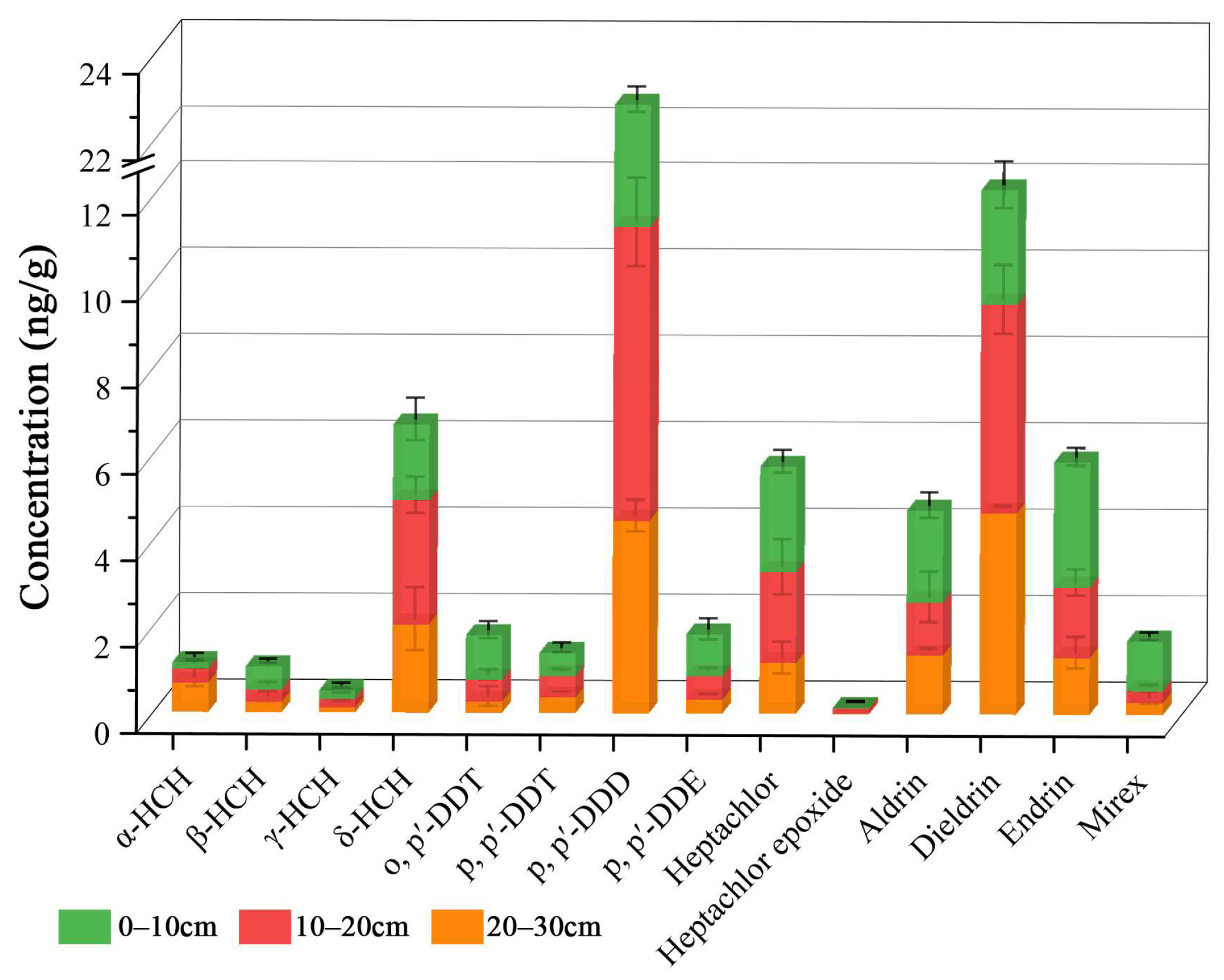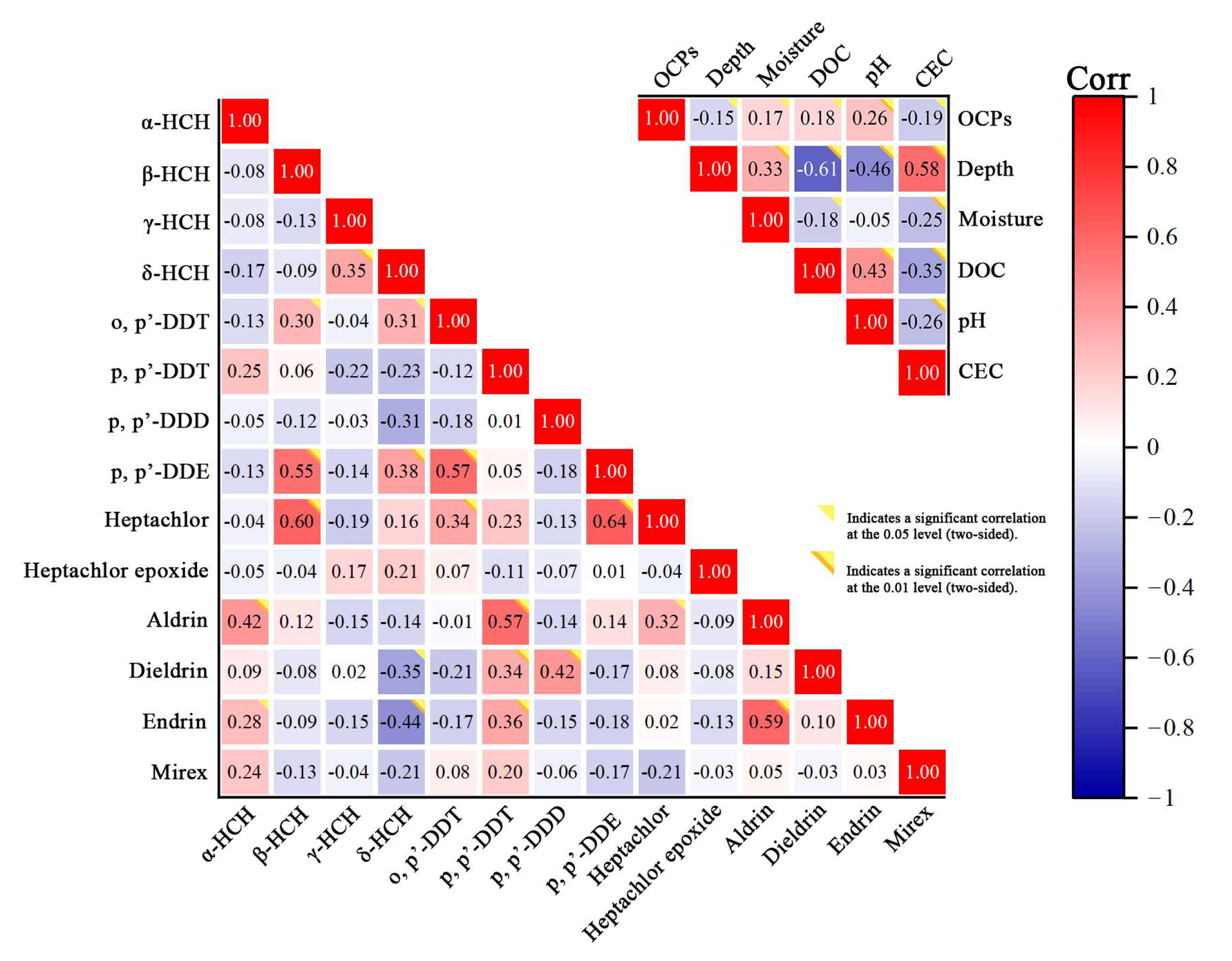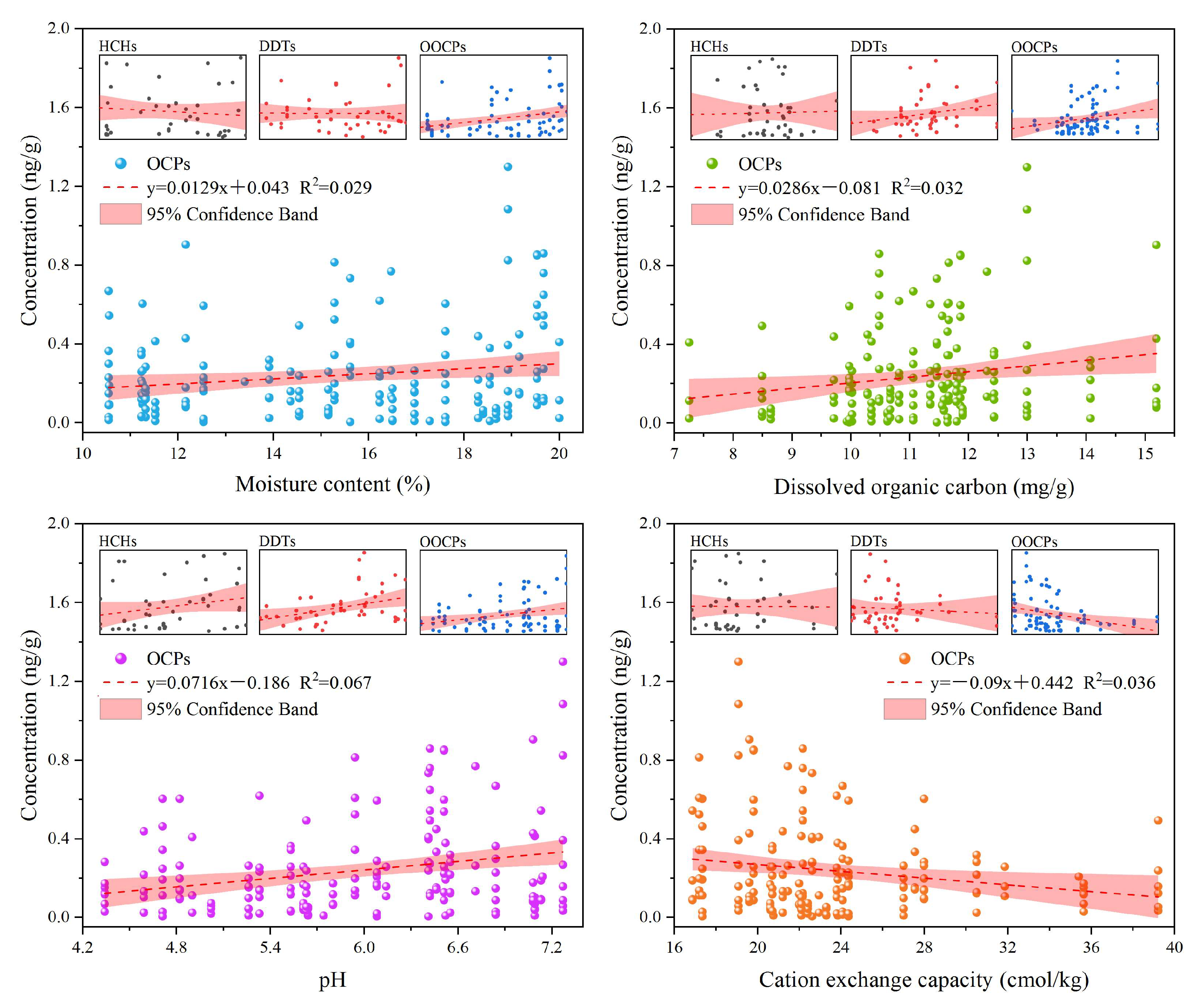Distribution Characteristics and Influencing Factors of Organochlorine Pesticides in Agricultural Soil from Xiamen City
Abstract
:1. Introduction
2. Materials and Methods
2.1. Sample Collection and Extraction
2.2. Instrumental Analysis
2.3. Quality Control and Quality Assurance
2.4. Statistical Analysis
3. Results and Discussion
3.1. General Situation Regarding Agricultural Soil (Distribution Characteristics of OCPs in Agricultural Soils of Xiamen)
3.2. Effects of Soil Properties on Concentration of OCP Pesticides
3.3. Potential Ecosystem Risk Assessment
4. Conclusions
Supplementary Materials
Author Contributions
Funding
Institutional Review Board Statement
Informed Consent Statement
Data Availability Statement
Conflicts of Interest
References
- Zhang, Y.; Qi, S.; Xing, X.; Yang, D.; Devi, N.L.; Qu, C.; Liu, H.-X.; Zhang, J.-Q.; Zeng, F.-M. Environmental Geochemistry, 2nd ed.; De Vivo, B., Belkin, H.E., Lima, A., Eds.; Elsevier: Amsterdam, The Netherlands, 2018; pp. 543–565. [Google Scholar]
- Oyinloye, J.A.; Oyekunle, J.A.O.; Ogunfowokan, A.O.; Msagati, T.; Adekunle, A.S.; Nety, S.S. Human health risk assessments of organochlorine pesticides in some food crops from Esa-Oke farm settlement, Osun State, Nigeria. Heliyon 2021, 7, e07470. [Google Scholar] [CrossRef] [PubMed]
- Sparling, D.W. (Ed.) Ecotoxicology Essentials; Academic Press: San Diego, CA, USA, 2016; pp. 69–107. [Google Scholar]
- Zeng, J.Y.; Miao, Y.; Liu, C.; Deng, Y.L.; Chen, P.P.; Zhang, M.; Cui, F.P.; Shi, T.; Lu, T.T.; Liu, C.J.; et al. Serum multiple organochlorine pesticides in relation to testosterone concentrations among Chinese men from an infertility clinic. Chemosphere 2022, 299, 134469. [Google Scholar] [CrossRef] [PubMed]
- Han, M.; Ma, A.; Dong, Z.; Yin, J.; Shao, B. Organochlorine pesticides and polycyclic aromatic hydrocarbons in serum of Beijing population: Exposure and health risk assessment. Sci. Total Environ. 2023, 860, 160358. [Google Scholar] [CrossRef]
- Shah, H.K.; Sharma, T.; Banerjee, B.D. Organochlorine pesticides induce inflammation, ROS production, and DNA damage in human epithelial ovary cells: An in vitro study. Chemosphere 2020, 246, 125691. [Google Scholar] [CrossRef] [PubMed]
- Duodu, G.O.; Goonetilleke, A.; Ayoko, G.A. Factors influencing organochlorine pesticides distribution in the Brisbane River Estuarine sediment, Australia. Mar. Pollut. Bull. 2017, 123, 349–356. [Google Scholar] [CrossRef] [PubMed]
- Veludo, A.F.; Martins, F.D.; Degrendele, C.; Masinyana, L.; Curchod, L.; Kohoutek, J.; Kukučka, P.; Martiník, J.; Přibylová, P.; Klánová, J.; et al. Seasonal variations in air concentrations of 27 organochlorine pesticides (OCPs) and 25 current-use pesticides (CUPs) across three agricultural areas of South Africa. Chemosphere 2022, 289, 133162. [Google Scholar] [CrossRef] [PubMed]
- Ochoa, V.; Maestroni, B. Integrated Analytical Approaches for Pesticide Management; Maestroni, B., Cannavan, A., Eds.; Academic Press: Oxford, UK, 2018; pp. 133–147. [Google Scholar]
- Taiwo, A.M. A review of environmental and health effects of organochlorine pesticide residues in Africa. Chemosphere 2019, 220, 1126–1140. [Google Scholar] [CrossRef] [PubMed]
- Qu, C.; Qi, S.; Yang, D.; Huang, H.; Zhang, J.; Chen, W.; Yohannes, H.K.; Sandy, E.H.; Yang, J.; Xing, X. Risk assessment and influence factors of organochlorine pesticides (OCPs) in agricultural soils of the hill region: A case study from Ningde, southeast China. J. Geochem. Explor. 2015, 149, 43–51. [Google Scholar] [CrossRef]
- Mahmood, A.; Malik, R.N.; Li, J.; Zhang, G. Human health risk assessment and dietary intake of organochlorine pesticides through air, soil and food crops (wheat and rice) along two tributaries of river Chenab, Pakistan. Food Chem. Toxicol. 2014, 71, 17–25. [Google Scholar] [CrossRef]
- Zhang, J.; Liu, F.; Chen, R.; Feng, T.; Dong, S.; Shen, H. Levels of polychlorinated biphenyls and organochlorine pesticides in edible shellfish from Xiamen (China) and estimation of human dietary intake. Food Chem. Toxicol. 2012, 50, 4285–4291. [Google Scholar] [CrossRef]
- Tor, A.; Aydin, M.E.; Özcan, S. Ultrasonic solvent extraction of organochlorine pesticides from soil. Anal. Chim. Acta 2006, 559, 173–180. [Google Scholar] [CrossRef]
- Vagi, M.; Petsas, A.; Kostopoulou, M.; Karamanoli, M.; Lekkas, T. Determination of organochlorine pesticides in marine sediments samples using ultrasonic solvent extraction followed by GC/ECD. Desalination 2007, 210, 146–156. [Google Scholar] [CrossRef]
- Aiyesanmi, A.F.; Ademefun, A.E.; Ibigbami, O.A.; Adelodun, A.A. Polycyclic aromatic hydrocarbons and organochlorine pesticides in floodplain soils: A case study of Onuku River in Okitipupa, Nigeria. Environ. Chall. 2021, 5, 100351. [Google Scholar] [CrossRef]
- Zhao, C.; Xie, H.; Zhang, J.; Xu, J.; Liang, S. Spatial distribution of organochlorine pesticides (OCPs) and effect of soil characters: A case study of a pesticide producing factory. Chemosphere 2013, 90, 2381–2387. [Google Scholar] [CrossRef]
- Can-Güven, E.; Gedik, K.; Kurt-Karakuş, P.B. Organochlorine pesticides and polychlorinated biphenyls from a greenhouse area on the Mediterranean coast of Turkey: Distribution, air-soil exchange, enantiomeric signature, and source implications. Atmos. Pollut. Res. 2022, 13, 101263. [Google Scholar] [CrossRef]
- Chen, G. Encyclopedia of Toxicology, 3rd ed.; Wexler, P., Ed.; Academic Press: Oxford, UK, 2014; pp. 874–876. [Google Scholar]
- Sun, Y.; Chang, X.; Zhao, L.; Zhou, B.; Weng, L.; Li, Y. Comparative study on the pollution status of organochlorine pesticides (OCPs) and bacterial community diversity and structure between plastic shed and open-field soils from northern China. Sci. Total Environ. 2020, 741, 139620. [Google Scholar] [CrossRef] [PubMed]
- Zhou, Q.; Wang, J.; Meng, B.; Cheng, J.; Lin, G.; Chen, J.; Zheng, D.; Yu, Y. Distribution and sources of organochlorine pesticides in agricultural soils from central China. Ecotoxicol. Environ. Saf. 2013, 93, 163–170. [Google Scholar] [CrossRef] [PubMed]
- Jiang, Y.; Wang, X.-T.; Jia, Y.; Wang, F.; Wu, M.-H.; Sheng, G.-Y.; Fu, J.-M. Occurrence, distribution and possible sources of organochlorine pesticides in agricultural soil of Shanghai, China. J. Hazard. Mater. 2009, 170, 989–997. [Google Scholar] [CrossRef]
- Yang, D.; Qi, S.-H.; Zhang, J.-Q.; Tan, L.-Z.; Zhang, J.-P.; Zhang, Y.; Xu, F.; Xing, X.-L.; Hu, Y.; Chen, W.; et al. Residues of Organochlorine Pesticides (OCPs) in Agricultural Soils of Zhangzhou City, China. Pedosphere 2012, 22, 178–189. [Google Scholar] [CrossRef]
- Wang, C.; Wang, X.; Gong, P.; Yao, T. Residues, spatial distribution and risk assessment of DDTs and HCHs in agricultural soil and crops from the Tibetan Plateau. Chemosphere 2016, 149, 358–365. [Google Scholar] [CrossRef] [PubMed]
- Yun, S.-M.; Yoon, J.-K.; Kim, J.-I.; Kim, I.J.; Kim, H.-K.; Chung, H.-M.; Kim, D.-J.; Noh, H.-J. Evaluation of residual level and distribution characteristics of organochlorine pesticides in agricultural soils in South Korea. Environ. Sci. Pollut. Res. 2022, 29, 46003–46017. [Google Scholar] [CrossRef] [PubMed]
- Alshemmari, H.; Al-Shareedah, A.E.; Rajagopalan, S.; Talebi, L.A.; Hajeyah, M. Pesticides driven pollution in Kuwait: The first evidence of environmental exposure to pesticides in soils and human health risk assessment. Chemosphere 2021, 273, 129688. [Google Scholar] [CrossRef] [PubMed]
- Wong, F.; Alegria, H.A.; Bidleman, T.F. Organochlorine pesticides in soils of Mexico and the potential for soil–air exchange. Environ. Pollut. 2010, 158, 749–755. [Google Scholar] [CrossRef]
- Bosch, C.; Grimalt, J.O.; Fernández, P. Enantiomeric fraction and isomeric composition to assess sources of DDT residues in soils. Chemosphere 2015, 138, 40–46. [Google Scholar] [CrossRef] [PubMed]
- Xiamen Meteorological Administration. Xiamen Climate Annual Report 2021; Xiamen Meteorological Administration: Xiamen, China, 2021; pp. 14–15. Available online: http://fj.cma.gov.cn/xmsqxj/qxfw/qhfw/202203/P020220304411202100720.pdf (accessed on 27 December 2022).
- Rico-Martínez, R.; Alvarado-Flores, J.; Pérez-Legaspi, I.A.; Garza-León, C.V.; Rivera-Dávila, O.L.; Santos-Medrano, G.E.; Robles-Vargas, D.; Carbajal-Hernández, A.L. Pesticides in the Natural Environment; Singh, P., Singh, S., Sillanpää, M., Eds.; Elsevier: Amsterdam, The Netherlands, 2022; pp. 65–119. [Google Scholar]




| Compounds | Agricultural Soils (n = 30) | ||
|---|---|---|---|
| Range (ng/g) | Mean (ng/g) | Detection Rate (%) | |
| α-HCH | ND–0.77 | 0.027 | 16.7 |
| β-HCH | ND–0.35 | 0.035 | 25.0 |
| γ-HCH | ND–0.23 | 0.017 | 13.3 |
| δ-HCH | ND–0.78 | 0.223 | 60.0 |
| ΣHCHs | ND–0.78 | 0.076 | 28.8 |
| o, p′-DDT | ND–0.40 | 0.060 | 35.0 |
| p, p′-DDT | ND–0.21 | 0.047 | 40.0 |
| p, p′-DDD | ND–10.04 | 0.761 | 58.3 |
| p, p′-DDE | ND–0.58 | 0.061 | 30.0 |
| ΣDDTs | ND–10.04 | 0.232 | 40.8 |
| Hexachlorobenzene | ND | ||
| Heptachlor | ND–0.86 | 0.191 | 66.7 |
| Heptachlor epoxide | ND–0.13 | 0.003 | 11.7 |
| Aldrin | ND–0.93 | 0.157 | 46.7 |
| Dieldrin | ND–3.74 | 0.405 | 48.3 |
| Endrin | ND–1.09 | 0.195 | 46.7 |
| Mirex | ND–0.94 | 0.057 | 30.0 |
| ΣOOCPs | ND–3.74 | 0.144 | 35.7 |
| ΣOCPs | ND–10.04 | 0.149 | 35.2 |
| Index | Observed Range | Arithmetric Mean | Standard Deviation |
|---|---|---|---|
| Moisture (%) | 10.54–20.00 | 15.520 | 3.078 |
| Dissolved organic carbon (mg/g) | 7.25–15.19 | 11.062 | 1.581 |
| pH | 4.34–7.27 | 5.974 | 0.848 |
| Cation exchange capacity (cmol/kg) | 16.87–39.21 | 24.107 | 5.587 |
Disclaimer/Publisher’s Note: The statements, opinions and data contained in all publications are solely those of the individual author(s) and contributor(s) and not of MDPI and/or the editor(s). MDPI and/or the editor(s) disclaim responsibility for any injury to people or property resulting from any ideas, methods, instructions or products referred to in the content. |
© 2023 by the authors. Licensee MDPI, Basel, Switzerland. This article is an open access article distributed under the terms and conditions of the Creative Commons Attribution (CC BY) license (https://creativecommons.org/licenses/by/4.0/).
Share and Cite
Gao, Z.; Chen, Y.; Qin, Q.; Wang, R.; Dai, Z. Distribution Characteristics and Influencing Factors of Organochlorine Pesticides in Agricultural Soil from Xiamen City. Int. J. Environ. Res. Public Health 2023, 20, 1916. https://doi.org/10.3390/ijerph20031916
Gao Z, Chen Y, Qin Q, Wang R, Dai Z. Distribution Characteristics and Influencing Factors of Organochlorine Pesticides in Agricultural Soil from Xiamen City. International Journal of Environmental Research and Public Health. 2023; 20(3):1916. https://doi.org/10.3390/ijerph20031916
Chicago/Turabian StyleGao, Ziqiang, Yixian Chen, Qijin Qin, Rui Wang, and Zhineng Dai. 2023. "Distribution Characteristics and Influencing Factors of Organochlorine Pesticides in Agricultural Soil from Xiamen City" International Journal of Environmental Research and Public Health 20, no. 3: 1916. https://doi.org/10.3390/ijerph20031916






